8/1/2023
Optimize Nutrient Uptake
Susan Parent

A considerable number of fertilizers are on the market, providing plants with programs either general or specific to crops, but plants can have challenges to absorb these nutrients. What are the causes?
Growing media pH
Traditionally, plant nutrition is based on three major plant nutrients of N, P and K; secondary elements Ca, Mg, and SO4; and minor elements Fe, Mn, B, Cu, Mo and Zn. Even though the required quantity of minor elements is less in comparison with major elements, their importance in plant nutrition is crucial. Nutrient availability is dependent on pH, so the optimal pH range of 5.5 to 6.2 for growing media is ideal for most plants to obtain nutrients. Table 1 shows how nutrient availability will vary according to the pH of the growing medium.
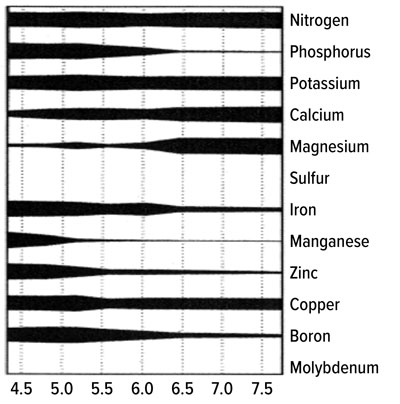 Table 1. Availability of mineral nutrients according to the pH of growing media. Source: William R. Argo, Paul Robert Fisher, “Understanding pH Management for Container-grown Crop”
Table 1. Availability of mineral nutrients according to the pH of growing media. Source: William R. Argo, Paul Robert Fisher, “Understanding pH Management for Container-grown Crop”
Different plant species have different ideal pH ranges due to the availability of micronutrients. Plants have different abilities to absorb nutrients, especially micronutrients, and pH is a strong determinant in their capacity to use fertilizers provided.
Plants can be divided into three groups:
1. Geranium plant group: This plant group requires a growing pH of 6.0 to 6.6. This group becomes sensitive to iron and manganese toxicity if the pH goes down below this pH range. Plants in this group include geranium, new guinea impatiens, marigold, lisianthus, pentas, etc.
2. Petunia plant group: This plant group is prone to iron deficiency, which means they require a more acidic growing medium pH of 5.4 to 6.0. If the pH is higher, then these plants may exhibit iron deficiency. Plants in this group include calibrachoa, petunia, bacopa, diascia, dianthus, nemesia, pansy, scaevola, verbena, vinca, etc.
3. General plant group: Plants in this group can grow at a pH of 5.8 to 6.2 and aren’t prone to iron and other micronutrient toxicities or deficiencies. Plants in this group include chrysanthemum, impatiens, ivy geranium, osteospermum, poinsettia, etc.
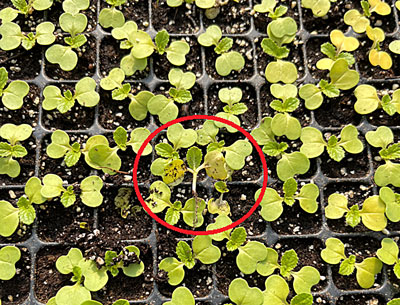
Other factors that affect nutrient availability
When using growing media made with peat moss and other organic-based materials, a wetting agent is added to reduce the surface tension, so it will have more uniform water absorption and distribution. Fertilizer elements come from the fertilizer solution, so the more fertilizer solution absorbed, the more nutrients are available to plants. As a growing medium ages, the wetting agent is broken down so less fertilizer solution is absorbed by the growing medium and this can cause symptoms of nutrient deficiency.
Figure 1. Root disease is damaging the roots of these seedlings and they’re chlorotic because they’re incapable of absorbing the nutrients.
There are also stresses related to plant root pathogens that can cause deficiency symptoms because the roots become damaged and are no longer capable of providing the nutrients to plants. Figure 1 shows chlorosis of seedlings that are affected by root disease that causes brown root rot.
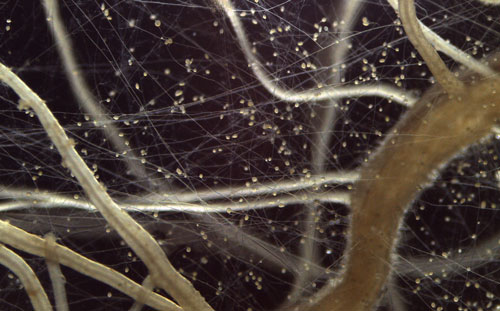
Pictured: Mycorrhizal fungi increases the root zone absorption area.
Microorganisms in the growing media or soil
Another side of plant nutrition that’s less considered is the role played by the microorganisms. However, more and more studies have shown crops perform better, especially under stressful conditions, when microorganisms or mycorrhizal fungi are used. Among the microorganisms available, mycorrhizal fungi is best known for increasing the absorption area of the root systems, so it helps improve efficiency of nutrient absorption in a soil or soilless growing media.
In organic growing conditions, mycorrhizal fungi, as well as microorganisms, naturally present in soils or growing media play an important role in mineralization of organic nutrients.
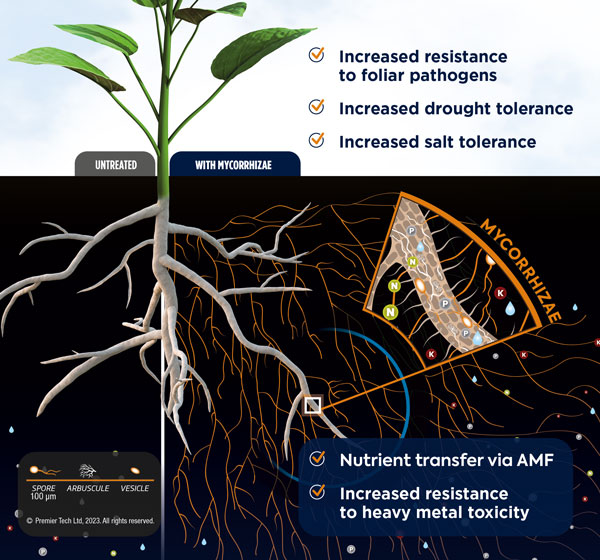
How does mycorrhizae work in growing media?
In soil that’s been tilled or rototilled for new planting beds and commercial growing media, Arbuscular mycorrhizal fungi (AMF) are almost always absent. Using a growing medium pre-inoculated with AMF, such as PRO-MIX with MYCORRHIZAE, is the quickest way to get the plant roots colonized and subsequently receive benefits.
AMF spores germinate after planting and produce hyphae that reach out to colonize plant roots. Within a couple of weeks, new hyphae are formed that explore the soil to acquire nutrients that aren’t available to plant roots.
Figure 2. Illustration of a root system with and without the presence of Arbuscular Mycorrhizal Fungi (AMF). The hyphae in orange illustrate the extension provided by the fungi into the soil to access the nutrients.
With this extension in the soil through the hyphae, water and nutrients that are less mobile become accessible to the hyphae and brought back to the plant roots (Figure 2). This is of great importance, especially when plants are under stress from drought, nutrition or heat (Figure 3).
To maximize the investment in fertilizers, use of mycorrhizal fungi inoculants at the beginning of the crop cycle will provide plants with more resistance to stressful growing conditions. Even under the best growing conditions, most plants cannot reach all the nutrients provided. The following factors should be considered when growing horticultural crops:
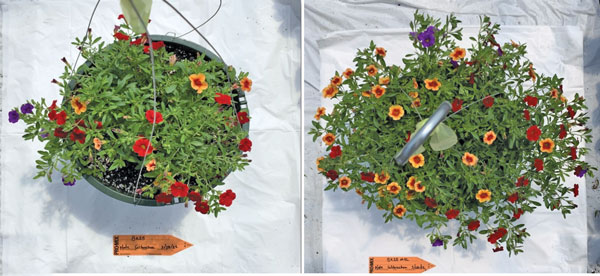 • Monitor the pH of the growing medium and ensure it’s within the proper range for the crop grown. Irrigation water should be analyzed for bicarbonates, as high levels can quickly increase the pH of the growing medium.
• Monitor the pH of the growing medium and ensure it’s within the proper range for the crop grown. Irrigation water should be analyzed for bicarbonates, as high levels can quickly increase the pH of the growing medium.
Figure 3. The plant on the right is inoculated with mycorrhizal fungi, but the one on the left was not. Stresses were the same for both plants—the presence of the mycorrhiza was helpful in acquiring water and nutrients, so the inoculated plants were larger by the end of the growing season.
• Hard-to-wet growing medium with insufficient wetting agent can contribute to nutrient disorders. Adding wetting agent can be a good way to make better use of the fertilizer applied.
• Plants under stress (disease, heat, water stress) won’t be able to absorb all the nutrients available from the growing medium or soil, leading to potential nutrient disorders. Be sure the greenhouse environment doesn’t encourage disease by implementing good ventilation, plant spacing and use of biocontrol programs.
• Using mycorrhizal fungi or other biostimulants in the growing media will provide roots with greater access to plant nutrients, or in the case of mycorrhizae, transfer nutrients to plant roots, especially under stressful growing conditions.
For more information about mycorrhizae, biostimulants and plant culture, check our website at pthorticulture.com or contact one of our Grower Services representatives for assistance. GT
Susan Parent is a Horticulture Specialist—Eastern Canada for Premier Tech.